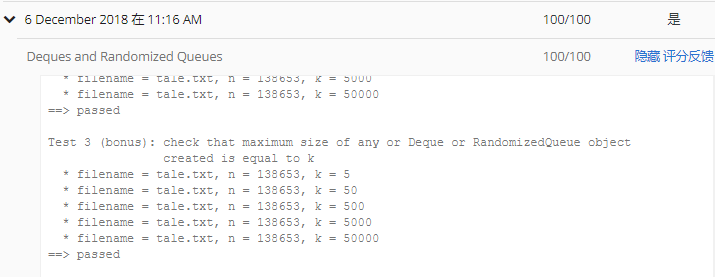编程作业二
作业链接:Deques and Randomized Queues & Checklist
我的代码:Deque.java & RandomizedQueue.java & Permutation.java
问题简介
Write a generic data type for a deque and a randomized queue. The goal of this assignment is to implement elementary data structures using arrays and linked lists, and to introduce you to generics and iterators.
任务摘要
Dequeue. A double-ended queue or deque (pronounced “deck”) is a generalization of a stack and a queue that supports adding and removing items from either the front or the back of the data structure. Create a generic data type Deque that implements the following API:
public class Deque<Item> implements Iterable<Item> { public Deque() // construct an empty deque public boolean isEmpty() // is the deque empty? public int size() // return the number of items on the deque public void addFirst(Item item) // add the item to the front public void addLast(Item item) // add the item to the end public Item removeFirst() // remove and return the item from the front public Item removeLast() // remove and return the item from the end public Iterator<Item> iterator() // return an iterator over items in order from front to end public static void main(String[] args) // unit testing (optional) }Randomized queue. A randomized queue is similar to a stack or queue, except that the item removed is chosen uniformly at random from items in the data structure. Create a generic data type RandomizedQueue that implements the following API:
public class RandomizedQueue<Item> implements Iterable<Item> { public RandomizedQueue() // construct an empty randomized queue public boolean isEmpty() // is the randomized queue empty? public int size() // return the number of items on the randomized queue public void enqueue(Item item) // add the item public Item dequeue() // remove and return a random item public Item sample() // return a random item (but do not remove it) public Iterator<Item> iterator() // return an independent iterator over items in random order public static void main(String[] args) // unit testing (optional) }Iterator. Each iterator must return the items in uniformly random order. The order of two or more iterators to the same randomized queue must be mutually independent; each iterator must maintain its own random order.
Client. Write a client program Permutation.java that takes an integer k as a command-line argument; reads in a sequence of strings from standard input using StdIn.readString(); and prints exactly k of them, uniformly at random. Print each item from the sequence at most once.
详细的要求参见:specification。
问题分析
第二次作业比较简单,主要想让我们用数组和链表实现基础的数据结构,介绍 Java 的泛型和迭代器,还可以参考 ResizingArrayStack.java 和 LinkedStack.java。
任务一要求实现双端队列,即在队列的首尾都可以进行插入和删除操作。因为性能要求里要每次操作都保证在常数时间内完成,所以选择链表实现。确定了实现方式,不行再照着课程样例,建议加的哨兵节点也没什么问题。
任务二要求实现随机队列,随机出队,每个位置出去的概率一样,迭代器返回的顺序也要是随机的。Checklist 里的提示降低了很多难度:
What is meant by uniformly at random?
If there are n items in the randomized queue, then you should choose each one with probability 1/n, up to the randomness of StdRandom.uniform(), independent of past decisions. You can generate a pseudo-random integer between 0 and n−1 using StdRandom.uniform(n) from StdRandom.
Given an array, how can I rearrange the entries in random order?
Use StdRandom.shuffle()—it implements the Knuth shuffle discussed in lecture and runs in linear time. Note that depending on your implementation, you may not need to call this method.
所以这个随机队列用数组实现就比较方便,随机数组下标好操作,也符合作业的目的,一个用链表,一个用数组。而且,任务二性能要求空间部分,也保证我们用变长数组才能拿到满分,总之,课程设计还是很厉害的。于是,任务二也没什么问题。
任务三的测试程序,要求从文件里读入 N 个字符串,然后随机输出 K 个。直接把 N 个字符串压入任务二的随机队列,然后输出 K 个就行。但是,还有个额外的挑战:
For an extra challenge, use only one Deque or RandomizedQueue object of maximum size at most k.
挑战不能直接压入 N 个,队列里最多只能放 K 个字符串,大概是这次作业最难的部分了。当初是没有想出来,找到这篇博客才拿到了额外的分数。
测试结果

填坑,继续小号提交原来通过的代码。